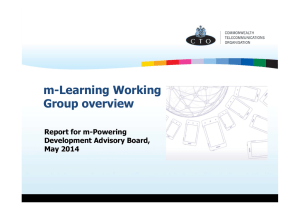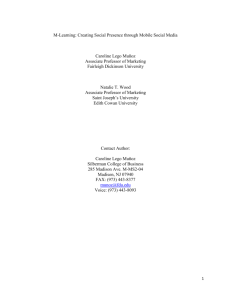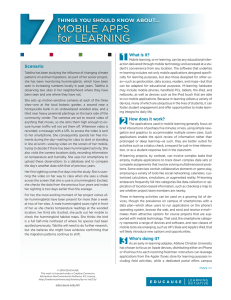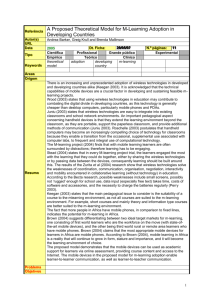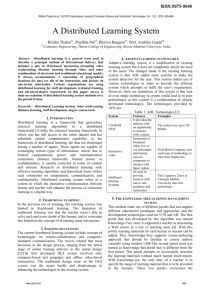Mobile_and_E-learning
advertisement
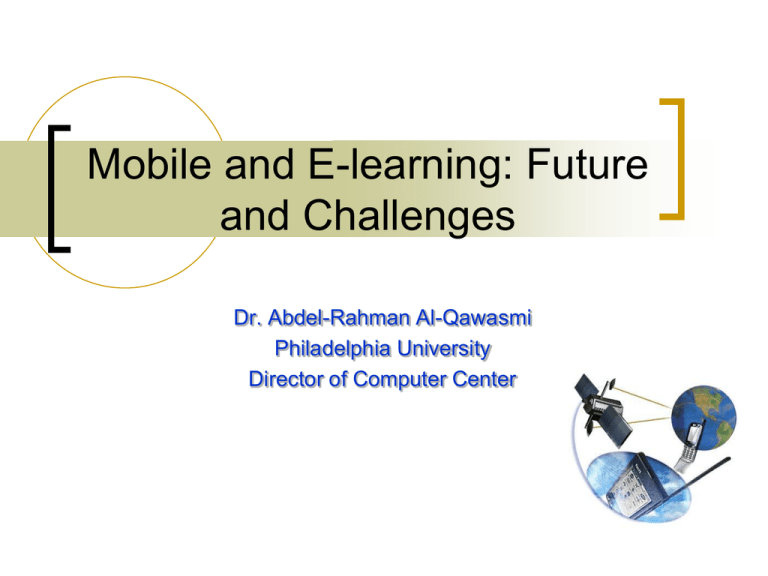
Mobile and E-learning: Future and Challenges Dr. Abdel-Rahman Al-Qawasmi Philadelphia University Director of Computer Center Introduction Mobile technologies are a familiar part of the lives of most teachers and students in the world today. Newer developments in mobile phone technology are beginning to offer the potential for rich multimedia experiences and for location-specific resources. The challenge for educators and designers, however, is one of understanding and exploring how best we might use these resources to support learning In recent years the quick growth of mobile technologies is promising a new revolution that might be comparable with the Web Introduction The existing wide range of mobile devices and wireless technologies gives an opportunity to realise different systems for mobile education. For example some of these systems can be used only in the area of a university or company, as at the same time other systems ensure a broader usage outside the educational institutions. Some of the systems support user access only to the administrative information, while other systems support an access to educational materials. There is considerable interest from educators and technical developers in exploiting the unique capabilities and characteristics of mobile technologies to enable new forms of learning Definition of Mobile Learning In general by mobile device we mean personal digital assistants PDAs , digital cell phone, smart phones, notebooks or Tablet that can be used for some form of formal or informal learning anywhere at anytime .These devices must support wireless technology and have a possibility to present teaching Mobile learning is a field which combines mobile computing and e-learning Mobile Devices for Learning Citizens are used to carrying everywhere with them, Which they regard as friendly and personal devices, Which are cheap and easy to use, Which they use constantly in all walks of life and in a variety of different settings. Desktops and Laptops are not Mobile learning Devices Benefits of m-learning learning available anywhere and anytime: allowing learners to participate in educational activities without the restrictions of time and place. Mobile technologies have the power to make learning even more widely available and accessible than we are used to in existing e-learning environments. Wireless and mobile technologies also make it possible to provide learning opportunities to learners that are either without infrastructure for access M-learning thrives within the contemporary social constructivist paradigm because of its richness in terms of communication and interaction, both synchronous and asynchronous Benefits of m-learning Mobile technologies enrich learning possibilities even more and take it further because it is a natural extension of eLearning M-learning provides more mobility, flexibility and convenience than online learning m-learning uses mobile devices that have certain capabilities that can be delivered with greater ease than other electronic devices: Audio applications and Multimedia support. e-learning and m-learning can and should contribute to the quality of education because of the rich communication and interaction environment it provides. Mobile Learning Projects There are four major projects in mobile learning funded by the European Commission in Brussels: Leonardo da Vinci Ericsson Education Dublin From e-learning to m-learning Leonardo da Vinci Ericsson Education Dublin Mobile learning: The next generation of learning IST FP5 LSDA UK The m-learning project IST FP5 Giunti Ricerca Italy The MOBILearn project Leonardo da Vinci Ericsson Education Dublin From e-learning to m-learning The From e-learning to m-learning project addressed the development of courseware for mobile phones, smartphones and PDAs. What was important about this project was that the main pedagogical problems of developing mobile learning for PDAs were solved in the project From e-learning to m-learning, in which a comfortable didactic environment was created by using Microsoft Reader Works, providing each student with Microsoft Reader software to display the content and which was adjudged highly satisfactory by surveys of students who had studied a full course by mobile learning on a PDA Leonardo da Vinci Ericsson Education Dublin Mobile learning: The next generation of learning the next generation of learning project are installing a webauthoring tool like Macromedia Dreamweaver MX Version 1.0, installing a desk-top browser e.g. Opera 6.31 that has page rendering characteristics similar to a mobile phone, using XHTML 1.0 Transitional to code the web pages, using Cascading Style Sheets (CSS) to separate presentation style from document content, arranging each course page as a vertical column of content of at most 208 pixels, designing the user interface so that the limited screen space available is utilised as efficiently as possible,designing concise neat diagrams to fit the small screen, using Adobe Photoshop to produce light weight GIFs for mobile devices. IST FP5 LSDA UK The m-learning project This project had an important social dimension. It recognised that there were in the United Kingdom many 16 to 20 year old youths who were unemployed and had urgent needs for additional training, but who refused to attend a training centre or college. They were unemployable and refused to attend training. They all had, however, a mobile phone which they used constantly. The project, therefore, set out to develop courses for them on their mobile phones in the fields of literacy, numeracy and social skills. The focus of the project was on mobile phones, as this type of student did not possess either smartphones or PDAs. M-learning model: Downloading of content and access to study materials e-mail/bulletin board/chat room (communication and interaction) working through multimedia and /or simulations on CDRom communication and interaction from and with educational institution communication and interaction with peer learners and study groups browsing e-learning course material downloading study guides/manuals receive tutorial letters M-Learning Model for Africa 2005 Dr Tom H Brown Deputy Director Telematic Learning and Education Innovation University of Pretoria South Africa M-learning model: complete multiple choice assessment with immediate feedback send template based multimedia messages to institution (templates designed and provided by institution) generic feedback on assignments and examinations motivational messages tutor services: Administrative support via SMS, MMS, WAP and EPSS, integrated with the Internet downloading of material (sections of learning materials, assignments, letters, etc.) M-Learning Model for Africa 2005 Dr Tom H Brown Deputy Director Telematic Learning and Education Innovation University of Pretoria South Africa M-learning model: receive course schedule and calendar administrative information (reminders, notifications, urgent information, etc) access to institutions M-portal on the web access to examination and test marks via mobile service number or M-portal access to financial statements and registration data via mobile service number daily tips M-Learning Model for Africa 2005 Dr Tom H Brown Deputy Director Telematic Learning and Education Innovation University of Pretoria South Africa


